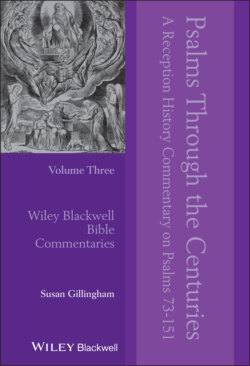Читать книгу Psalms Through the Centuries, Volume 3 - Susan Gillingham - Страница 27
Psalm 83: An Individual Lament about Ongoing Exile
ОглавлениеPsalm 83 looks at the injustice in the world from the viewpoint of the scheming of the nations, and is similar to Psalm 82, which looked at injustice from the perspective of a heavenly council. Just as Ps. 82:7–8 is about the deposition of the gods and their nations, Ps. 83:18 is also about the defeat of foreign nations; both end similarly, that Israel’s God, the ‘Most High’ (82:6 and 83:18) is God of all nations. So, again, we may note the first stage of reception in the placing of similar psalms alongside one another.
This psalm falls into two strophes: verses 1–8, which list nine nations who allegedly join together in a ‘covenant’ against Israel, and verses 9–18, which describe their being scattered throughout the world because of it. The psalm ends, unusually, with naming God as ‘Adonai’, thus anticipating this frequent use of this name in the *Korahite psalms which follow. (In the *Asaphite collection the usual name for God is Elohim.) This psalm is an interesting conclusion to this collection: after all the trauma of defeat and destruction, it envisages all nations coming to acknowledge God’s power. *Targum makes this point clearer by naming the king of Assyria as Sennacherib in verse 9 (Eng. v. 8). Hence the alliance of nine nations in verses 6–12 includes a tenth—namely Assyria, a horrific symbol of hostility—a nation which has been referred to in the reception of several psalms in this collection.
Psalm 83 is used at Passover along with Psalm 135 (Sop. 18.2).172 This is appropriate in its claims about God’s protection of Israel in the past, and about all nations acknowledging the ‘Most High’ in the future.
In the *Septuagint the translation of verse 3 reads that the enemies no longer conspire against God’s ‘protected ones’ (the noun in Hebrew comes from the verb ṣ-p-n, ‘to shelter’ or ‘hide’) but against God’s ‘holy ones’ (kata tōn hagiōn sou). An allusion to the Temple is made more explicit in changing the Hebrew phrase ‘Let us take the pastures of God for our own possession’ to ‘Let us take the holy place of God (to hagiastērion tou theou) for our own possession’.173 The attack on the Jerusalem Temple by Antiochus Epiphanes in the second-century BCE may well have a more sacral emphasis in later tradition.
The names of the enemies (verses 5–12) have had an interesting reception in Christian tradition. *Jerome applies these names to schismatics in the church: these are now those ‘in the churches of Christ (who) read of the tents of Edom, and the Ishmaelites, and so on, with all other names’.174 Similarly *Theodoret of Cyrus refers to the enemies as priests, deacons, and leaders of the church, all who are tainted with heresy.175 The argument of *Aquinas, by contrast, is that the enemies are those outside the church: these are the Jews and all other persecutors of the church.176 A sermon on Psalm 83 by *Erasmus (1533) understands the nine ‘enemies’ in the psalm to have even broader scope: his ‘On Restoring the Unity of the Church’ has specific references to the Turkish threat and the effects of the Reformation.177
Images in art have two main themes. The *Utrecht Psalter (fol. 48v) and the related *Eadwine Psalter (fol. 147r) depict military scenes of God’s victory over pagan forces. By contrast, images in eastern Psalters tend to portray spiritual scenes of martyrdom set alongside images of the crucifixion: this is evident in the *Khludov Psalter (fol.83r), the *Pantokrator Psalter (fol. 115v), the *Barberini Psalter (fol. 143v), the *Bristol Psalter (fol. 139r), *Theodore Psalter (fol. 111r and 111v), and the *Hamilton Psalter (fol. 159r).178 One of the reasons for these latter images may be the use of the psalm, from the eighth-century onwards, in Good Friday liturgies and in burial liturgies such as the Office of the Dead.179 So whilst one tradition rejoices in military victory for the faithful, the other laments the departed.
The political resonance of this psalm was a key motif in metrical psalmody in the seventeenth-century. The version by *Sternhold and Hopkins was apparently sung by Cromwell before the Battle of Marston Moor in 1644, when an allied army of Parliamentary and Scottish troops led by Sir Thomas Fairfax and the Earl of Manchester inflicted a heavy defeat on the Royalists. Cromwell wrote about the outcome that ‘God made them as stubble to our swords…’, an allusion to Ps. 83:13.180 It is easy to see how the Sternhold and Hopkins version could be applied to seventeenth-century politics:
Make Them Now and Their Lords Appear
like Zeb and Oreb then;
As Zebu and Zalmana were,
the kings of Midian;
12. Who said, let us throughout this land,
in all the coasts abroad,
Possess and take into our hand
the fair houses of God…
17. And let them daily more and more
to shame and slander fall,
And in rebuke and obloquy
confound and sink them all;
18. That they may know and understand
thou art the God most high
And that thou dost with mighty hand
the world rule constantly.
The references to the scheming of the nations and then to their ultimate defeat has enabled this psalm to be used in many different political, social and ecclesial contexts, by Jews and Christians alike. The enemies may be identified in different ways both within and between the two traditions, but the final appeal to God’s ‘world rule’ is a constant in each.
